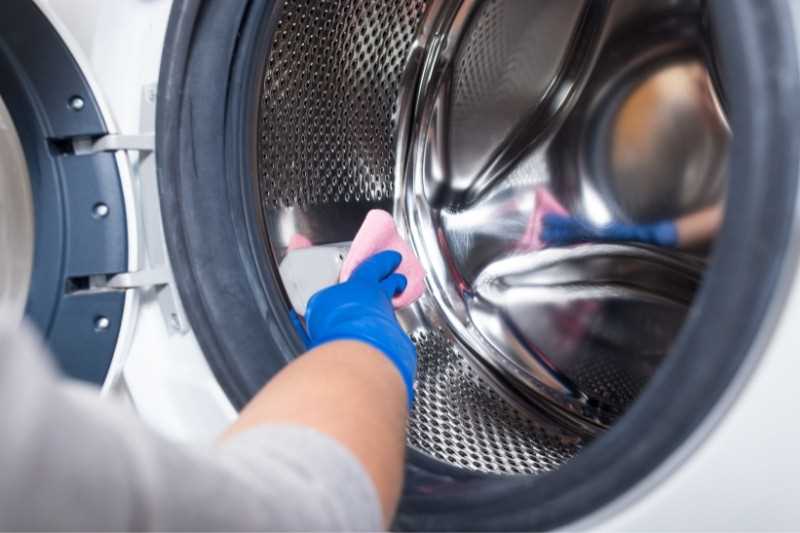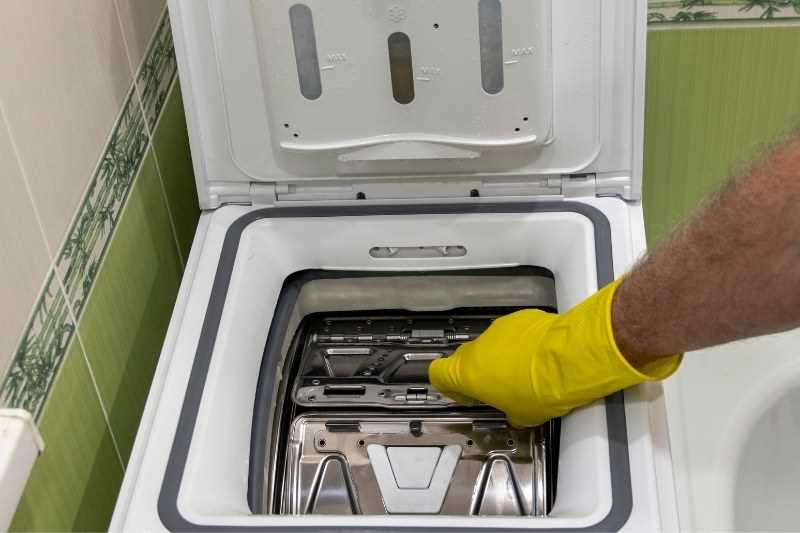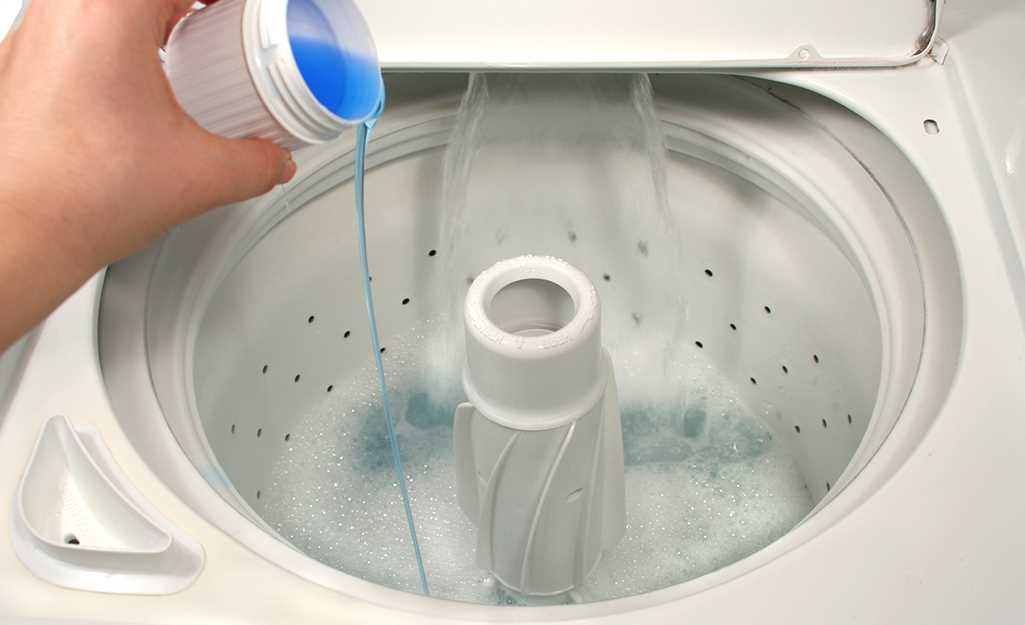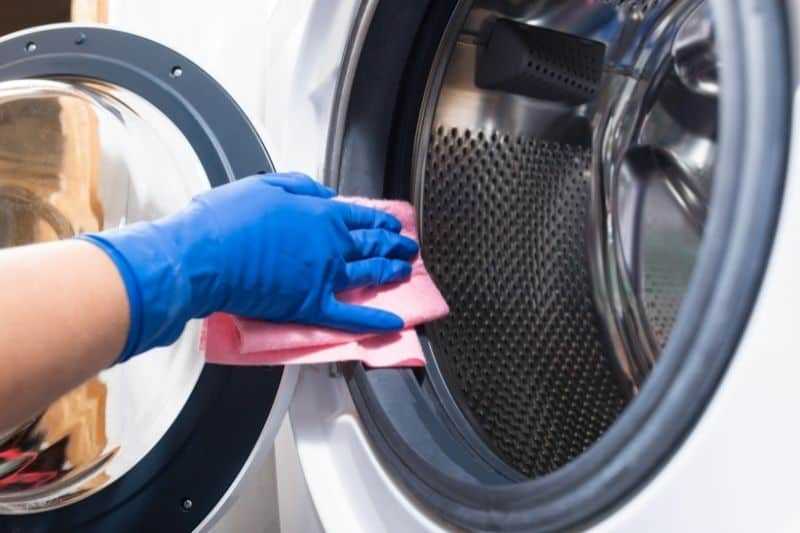


If you’ve recently taken your washing machine out of storage, you may notice that it doesn’t smell as fresh or function as well as it used to. It’s not uncommon for a washing machine that has been sitting idle for an extended period to develop some unpleasant odors and accumulated dirt or debris. However, with a few simple steps, you can easily restore your washing machine to its optimal condition.
Step 1: Run an Empty Cycle
Start by running an empty cycle with hot water and a cup of white vinegar. This will help get rid of any residual odors and clean out any buildup in the machine. Add the vinegar to the detergent dispenser or directly into the drum and run a normal cycle without any clothes.
Step 2: Scrub the Drum
After the empty cycle is complete, open the washing machine and scrub the drum with a mixture of baking soda and water. This will help remove any remaining dirt or grime. Use a sponge or cloth to scrub the drum thoroughly, paying special attention to any areas that appear particularly dirty.
Step 3: Clean the Dispensers and Filters
Next, clean the detergent dispenser and any other compartments or filters in your washing machine. These areas can easily accumulate residue and debris, which can affect the performance of your machine. Use a toothbrush or small brush to scrub them and ensure they are thoroughly cleaned.
Step 4: Wipe Down the Exterior
Finally, wipe down the exterior of the washing machine with a damp cloth. Pay attention to any visible dirt or stains and make sure to clean around the buttons and knobs. This will give your machine a fresh and clean appearance.
Following these simple steps can help ensure that your washing machine is clean, fresh, and ready to use after being in storage. Regularly cleaning your machine will also help maintain its performance and prevent any potential issues down the line.
Remember to consult your washing machine’s manual for specific instructions and recommendations on cleaning and maintenance.
Step-by-Step Guide: Cleaning a Stored Washing Machine
When you’ve had a washing machine in storage for a while, it’s important to clean it thoroughly before using it again. Dust, dirt, and other debris can accumulate over time, which can affect the performance of the machine. Follow these step-by-step instructions to ensure your stored washing machine is clean and ready to use.
Materials You’ll Need:
- Vinegar
- Baking soda
- A soft cloth
- A sponge
- A bucket
- Water
- A scrub brush or toothbrush
Step 1: Wipe Down the Exterior
Start by wiping down the exterior of the washing machine using a soft cloth and a mixture of water and a mild detergent. Pay special attention to any areas that may have accumulated dust or grime.
Step 2: Remove and Clean the Dispenser
Next, remove the detergent dispenser and give it a thorough cleaning. Use warm water and a scrub brush or toothbrush to scrub away any residue or buildup. Rinse it well and set it aside to dry.
Step 3: Clean the Interior

Fill the washing drum with a mixture of hot water and vinegar. Run a complete cycle on the hottest temperature setting, but skip the detergent. This will help remove any lingering odors and disinfect the interior of the machine.
Step 4: Clean the Seals and Gaskets
Check the seals and gaskets around the door or lid of the washing machine. Use a damp cloth and some mild detergent to clean them. Make sure to remove any dirt or grime that may have accumulated.
Step 5: Remove and Clean the Filter
Locate the filter of your washing machine and remove it. Refer to the manufacturer’s instructions if you’re unsure where it is located. Clean the filter in warm, soapy water and scrub away any debris. Rinse it thoroughly before reinstalling it.
Step 6: Clean the Drum and Tub
Mix a solution of equal parts water and baking soda to create a paste. Apply the paste to a sponge and scrub the inside of the drum and tub. Pay extra attention to any stains or stubborn residue. Rinse well with clean water.
Step 7: Run a Rinse Cycle

Finally, run an additional rinse cycle with clean water to ensure all cleaning agents are removed. This will also help eliminate any remaining odors.
Congratulations! Your stored washing machine is now clean and ready to use. Regular maintenance and cleaning will help ensure the longevity and performance of your appliance.
Preparing the Washing Machine

- Start by unplugging the washing machine from the power source.
- Remove any clothes or linens that may be in the machine.
- Check for any visible dirt or debris on the exterior of the machine and wipe it down with a cloth or sponge.
- Open the lid or door of the washing machine to access the inside.
- Inspect the inside of the machine for any visible dirt, mold, or residue.
- If there is any visible dirt or mold, wipe it away with a damp cloth or sponge.
Emptying the Water
- If the washing machine still has water in it, carefully empty it out.
- Place a bucket or large container below the drain hose.
- Loosen the clamp or plug on the drain hose to release the water.
- Allow the water to drain completely before moving on to the next step.
Removing the Filter
Many washing machines have filters that can become clogged with lint, hair, or other debris. It is important to clean or replace the filter before using the machine again.
- Locate the filter on your washing machine. It is usually located at the bottom front of the machine.
- Open the cover or remove the panel to access the filter.
- Check the filter for any visible debris or clogs.
- If necessary, remove the filter and clean it using warm water and a mild detergent.
- Once the filter is clean, place it back in the washing machine and secure the cover or panel.
Cleaning the Detergent Dispenser
The detergent dispenser can accumulate residue and buildup over time. Cleaning it will ensure that your washing machine runs smoothly.
- Remove the detergent dispenser drawer from the machine.
- Check for any visible residue or buildup in the drawer.
- If necessary, wash the drawer with warm water and a mild detergent to remove any residue.
- Allow the dispenser drawer to dry completely before placing it back in the washing machine.
Cleaning the Drum
The drum of the washing machine can also accumulate dirt, mold, and residue. Cleaning it thoroughly is important to ensure clean and fresh laundry.
- Prepare a cleaning solution by mixing equal parts water and white vinegar.
- Pour the cleaning solution into the drum of the washing machine.
- Close the lid or door of the washing machine and run a complete wash cycle using hot water.
- After the cycle is complete, open the lid or door and inspect the drum for any remaining dirt or residue.
- If necessary, wipe the drum with a cloth or sponge to remove any remaining dirt or residue.
Final Steps
- Once you have completed all the necessary cleaning steps, plug the washing machine back into the power source.
- Run a test cycle with no clothes to ensure that the machine is functioning properly.
- If you notice any issues or continue to experience problems, consult the manufacturer’s instructions or contact a professional for assistance.
Removing Dust and Debris
Before cleaning the washing machine, it is essential to remove any dust and debris that may have accumulated while it was in storage. Follow these steps to get rid of the dust and debris:
- Unplug the washing machine from the power source to ensure safety.
- Using a soft brush or cloth, gently sweep or wipe away any visible dust or debris on the exterior of the machine.
- Open the lid or door of the washing machine to access the drum.
- Inspect the drum for any visible dust, lint, or debris. Remove anything you see by hand or with a soft brush.
- Check the detergent dispenser or any other removable parts for dust or debris. Clean them separately if needed.
- Close the lid or door of the washing machine.
By thoroughly removing the dust and debris before cleaning, you will ensure that the cleaning process is more effective and prevent any potential clogs or blockages.
Cleaning the Drum and Dispenser
After the washing machine has been sitting in storage for a while, it is important to clean the drum and dispenser to remove any buildup or residue that may have accumulated.
1. Empty the drum and dispenser
Start by emptying the drum and the detergent dispenser of any leftover laundry or cleaning products. Remove any items that may be left behind, such as lone socks or other small pieces of clothing.
2. Mix a cleaning solution
In a bucket or sink, mix a solution of warm water and mild detergent. Use a gentle detergent that is suitable for your washing machine and avoid using abrasive cleaners or bleach.
3. Wipe down the drum

Dip a soft cloth or sponge into the cleaning solution and wring out any excess liquid. Wipe down the interior of the drum, paying special attention to any visible dirt or stains. Be sure to reach into any crevices or corners of the drum.
4. Clean the dispenser
Remove the detergent dispenser from the washing machine, if possible. Rinse it under warm water to remove any excess residue. Use a small brush or toothbrush to scrub away any built-up detergent or fabric softener. Rinse again and let it dry before reattaching it.
5. Rinse the drum
Once you have wiped down the drum, rinse it thoroughly with warm water to remove any remaining cleaning solution. This will help prevent any detergent or cleaner residues from affecting future cycles.
6. Dry the drum
Finally, use a clean, dry cloth to wipe down the inside of the drum. Make sure it is completely dry before closing the door. Leaving the drum damp can lead to unpleasant odors or mildew growth.
7. Clean the exterior
Don’t forget to clean the exterior of the washing machine as well. Wipe down the control panel, knobs, and any other surfaces with a damp cloth. If there are any stubborn stains, you can use a mild cleaning solution.
Following these steps to clean the drum and dispenser of your washing machine after it has been in storage will help ensure that it is ready to use and free of any buildup or residue. Regular cleaning and maintenance will also prolong the life of your washing machine and help it perform at its best.
Addressing Mold and Mildew
If your washing machine has been in storage for a long time, there is a possibility that mold and mildew may have developed. Here’s how you can address this issue:
1. Wear protective gear
Before you begin cleaning, make sure to wear gloves and a mask to protect yourself from potential mold spores.
2. Empty the machine
Remove any leftover water or clothing from the washing machine.
3. Inspect for mold and mildew
Check the drum, gasket, and detergent dispenser for any visible signs of mold or mildew. Pay special attention to any rubber seals, as they tend to harbor mold growth.
4. Remove mold and mildew
If you spot any mold or mildew, mix a solution of equal parts water and white vinegar. Dip a cloth or sponge into the solution and scrub the affected areas. For stubborn mold, you can also use a mildew cleaner approved for use on washing machines.
5. Clean the filters
Remove the filters and clean them thoroughly. Use a soft brush or toothbrush to remove any debris or buildup.
6. Run a hot water cycle

Fill the washing machine with hot water and add two cups of white vinegar. Run a complete wash cycle without any clothes. The vinegar will help kill any remaining mold and remove any lingering odors.
7. Wipe down the drum and exterior
After the cycle is complete, use a clean cloth or sponge to wipe down the drum and the exterior of the machine.
8. Keep the door open
Once the cleaning process is finished, leave the door of the washing machine open to allow air circulation and prevent mold growth in the future.
9. Regular maintenance
To prevent mold and mildew from returning, make sure to clean your washing machine regularly and leave it open between uses. Also, consider using a washing machine cleaner or running a maintenance cycle every few months to keep your machine in optimal condition.
By following these steps, you can effectively address mold and mildew in a washing machine that has been in storage and ensure that it functions properly.
Finishing Touches and Maintenance
Clean the exterior
After cleaning the inside of the washing machine, don’t forget to clean the exterior as well. Use a damp cloth and mild detergent to wipe down the surface of the machine. Pay attention to any stains or dirt that may have accumulated during storage. Dry the exterior with a clean cloth to prevent any water spots or streaks.
Inspect the hoses
Before using the washing machine, take a few moments to inspect the hoses. Look for any signs of cracks, bulges, or leaks. If you notice any damage, it’s important to replace the hoses before using the machine to prevent any water damage or flooding. Additionally, make sure the hoses are properly connected to the water source and the machine.
Check the filter
Some washing machines have a built-in filter that needs to be cleaned regularly to ensure optimal performance. Check the manufacturer’s instructions to locate the filter and remove any debris or lint that may have accumulated. Cleaning the filter on a regular basis can prevent clogs and improve the efficiency of the washing machine.
Run a maintenance cycle
Running a maintenance cycle can help keep your washing machine in good working condition. Follow the manufacturer’s instructions to run a maintenance cycle, which typically involves running an empty load with a specific cleaning solution or vinegar to remove any build-up or residue. This can help eliminate odours and keep your washing machine running smoothly.
Keep the door open
After each use and especially after cleaning, it’s important to leave the washing machine door open for a while to allow air to circulate and prevent the growth of mould and mildew. This is especially important if the machine will be put back into storage after use.
Maintain a cleaning schedule
To keep your washing machine in top condition, it’s a good idea to establish a regular cleaning schedule. This can include cleaning the tub, filter, and detergent dispenser as well as wiping down the exterior. Regular maintenance can help prolong the lifespan of your washing machine and prevent any issues from occurring.
| Tip | Description |
|---|---|
| Use the right amount of detergent | Using too much detergent can cause residue to accumulate in the machine. Follow the manufacturer’s guidelines for the appropriate amount to use. |
| Empty pockets before washing | Remove any objects or debris from pockets to prevent them from clogging the machine or damaging the drum. |
| Leave the lid or door open after use | Allow the interior to dry out and prevent the growth of mould and mildew. |
| Clean the detergent dispenser | Regularly remove and clean the detergent dispenser to prevent any residue from building up. |
| Wipe down the drum and seals | Regularly wipe down the drum and seals to prevent any residue or odours from developing. |
By following these steps and maintaining a regular cleaning schedule, you can keep your washing machine in excellent condition and ensure it continues to provide clean and fresh laundry.
FAQ
Why do I need to clean a washing machine that has been in storage?
If a washing machine has been in storage for an extended period of time, it may accumulate dust, dirt, and other debris. Cleaning it before use ensures that it is in optimal condition and will provide clean and fresh laundry.
What materials do I need to clean a washing machine that has been in storage?
You will need a bucket, mild detergent, white vinegar, a soft cloth or sponge, and a toothbrush. You may also need a wrench or pliers to remove any obstructed parts.
How do I clean the exterior of the washing machine?
To clean the exterior, mix a solution of warm water and mild detergent. Dip a soft cloth or sponge in the solution and wipe down the surfaces of the washing machine. Pay special attention to any areas with stains or dirt. Rinse with clean water and dry with a towel.
How do I clean the drum and the detergent dispenser?
To clean the drum, add two cups of white vinegar to the detergent dispenser and run the washing machine on a hot cycle. This will help remove any built-up residue and odours. To clean the detergent dispenser, remove it from the washing machine and wash it with warm water and mild detergent. Use a toothbrush to scrub away any stubborn residue.












